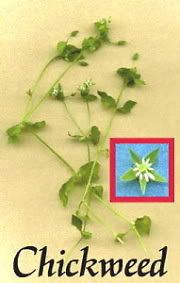
DESCRIPTION: A low, inconspicuous, European annual 3 to 8 inches tall, chickweed forms mats up to 16 inches long. Tiny, pointed, oval, UN toothed leaves, 1/2 to 1 inch long, grow in pairs (they're opposite). A fine line of hair extends along the length of the slender, delicate stem.
Tiny white flowers 1/8 inch across, with 5 petals so deeply cleft they look like 10, distinguish chickweed from other plants (Stellaria means star, referring to the flower). Five green sepals (modified leaves) grow as long as the petals they underlie.
Caution: Poisonous spotted spurge (Euphorbia maculata) also trails the ground with paired leaves, but with different flowers and white, milky sap, which chickweed lacks. Non-edible matted door weed or oval-leaf knot weed (Polygonum arenastrum) trails the ground as well, but its slender stem has alternate (singly configured) leaves.
You can eat all the many chickweed species. Common chickweed (S. media) has stalked leaves (media means ordinary). Star chickweed is (S. pubera) leaves are stalk less (pubera means downy). Mouse-ear chickweed (Cerastium vulgatum) is coarsely hairy.

HABITAT: Look for chickweed on lawns and in open, sunny areas, as well as partially shaded habitats.
SEASON: Growing all year, chickweed's best when no taller plants or tree leaves shade it out, throughout early spring and late fall, and during winter thaws.
Finding it for the first time was a major breakthrough for me. It meant that I wouldn't have to give up foraging all winter!

FOOD USES: Chop common and star chickweed, and add them, raw, to salads, or cook them like spinach. Mouse-ear chickweed ís so hairy, you have to cook it.
Chickweed gets its common name because chickens love it. Raw, it tastes like corn silk. I demonstrate this to school kids with a chicken imitation, then I grab the herb from the teacher's hand with my teeth and swallow it—corny, but consistent with the plant's flavor!
Cooked, chickweed tastes like spinach. Include any of the species in soups and stews, but cook no more than 5 minutes to prevent overcooking. Unlike most other edibles, the stems, as well as the leaves and flowers, taste good.
Cooking shrinks chickweed by 3/4, concentrating the nutrients and compensating for whatever vitamins cooking destroys.
NUTRITION: Chickweed is an excellent source of vitamins A, D, B complex, C, and rutin (an accompanying flavonoid), as well as iron, calcium, potassium, phosphorus, zinc, manganese, sodium, copper, and silica.
MEDICINAL USES: Applied externally, finely chopped chickweed soothes irritated skin, especially when mixed with marsh mallow (Althaea officinale) root. It's good for cuts, minor burns, eczema, and rashes. Bandage it on the affected area by itself or mixed with clay, which adds a drying and drawing effect. Change the dressing often.

Of course, try to uncover the cause of the skin malady and work to undo it. If you continually wake up with itchy, swollen areas on your skin every morning, you may find vigorous application of a fly swatter to the surface of the mosquito that's been camping out in your bedroom to be the remedy of choice!
To make chickweed infusion, pour 1 cup of boiling water over 1/4 cup of chickweed. Cover and let steep, off the heat, for 15 to 20 minutes. Strain out the herb and drink the tea hot.
A mild diuretic, promoting the flow of urine, this beverage is also supposed to cleanse and soothe the kidneys and urinary tract and help relieve cystitis. Unlike the more powerful pharmaceutical diuretics, it wont deplete the body of minerals. It is also reputedly good for rheumatism.

Here's a very simple, super-delicious way of preparing a chickweed side dish in a hurry. Serve hot over whole-grain noodles or toast.
12 cups chickweed, rinsed, drained, and chopped
1 tbs. olive oil, or to taste
1-1?2 tsp. lemon juice
æ tsp. salt, or to taste
‡ tsp. black pepper, or to taste
1. Steam the chickweed over low heat for 5 to 10 minutes, or until just wilted (avoid overcooking), covered, in a heavy saucepan, without any more water than what clings to the leaves after rinsing and draining, and without a steamer rack!
2. Stir in the remaining ingredients and heat to serving temperature.
Serves 6
Preparation time: 15 minutes

I love this little plant...I didn't know it was edible tho. I will have to try it next time I spot some...I know I've seen it in my own yard..now if I can just remember....lol!
ReplyDeleteLove Ya!